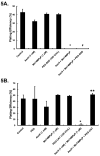Manganoporphyrins increase ascorbate-induced cytotoxicity by enhancing H2O2 generation
- PMID: 23764544
- PMCID: PMC3745518
- DOI: 10.1158/0008-5472.CAN-13-0470
Manganoporphyrins increase ascorbate-induced cytotoxicity by enhancing H2O2 generation
Abstract
Renewed interest in using pharmacological ascorbate (AscH-) to treat cancer has prompted interest in leveraging its cytotoxic mechanism of action. A central feature of AscH- action in cancer cells is its ability to act as an electron donor to O2 for generating H2O2. We hypothesized that catalytic manganoporphyrins (MnP) would increase AscH- oxidation rates, thereby increasing H2O2 fluxes and cytotoxicity. Three different MnPs were tested (MnTBAP, MnT2EPyP, and MnT4MPyP), exhibiting a range of physicochemical and thermodynamic properties. Of the MnPs tested, MnT4MPyP exerted the greatest effect on increasing the rate of AscH- oxidation as determined by the concentration of ascorbate radical [Asc•-] and the rate of oxygen consumption. At concentrations that had minimal effects alone, combining MnPs and AscH- synergized to decrease clonogenic survival in human pancreatic cancer cells. This cytotoxic effect was reversed by catalase, but not superoxide dismutase, consistent with a mechanism mediated by H2O2. MnPs increased steady-state concentrations of Asc•- upon ex vivo addition to whole blood obtained either from mice infused with AscH- or patients treated with pharmacologic AscH-. Finally, tumor growth in vivo was inhibited more effectively by combining MnT4MPyP with AscH-. We concluded that MnPs increase the rate of oxidation of AscH- to leverage H2O2 flux and ascorbate-induced cytotoxicity.
Figures







References
-
- Siegel R, Naishadham D, Jemal A, Naishadham D. Cancer statistics, 2013. CA Cancer J Clin. 2013;63:11–30. - PubMed
-
- Chen P, Stone J, Sullivan G, Drisko JA, Chen Q. Anti-cancer effect of pharmacologic ascorbate and its interaction with supplementary parenteral glutathione in preclinical cancer models. Free Radic Biol Med. 2011;51(3):681–7. - PubMed
-
- Chen Q, Espey MG, Sun AY, Lee JH, Krishna MC, Shacter E, Choyke PL, Pooput C, Kirk KL, Buettner GR, Levine M. Ascorbate in pharmacologic concentrations selectively generates ascorbate radical and hydrogen peroxide in extracellular fluid in vivo. Proc Natl Acad Sci U S A. 2007;104(21):8749–54. - PMC - PubMed
Publication types
MeSH terms
Substances
Grants and funding
LinkOut - more resources
Full Text Sources
Other Literature Sources
Medical
Miscellaneous

